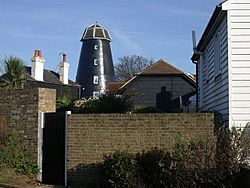Oare Windmill facts for kids
Quick facts for kids Oare Windmill |
|
|---|---|

The house converted mill
|
|
| Origin | |
| Grid reference | TR 009 625 |
| Coordinates | 51°19′35″N 0°52′57″E / 51.32639°N 0.88250°E |
| Year built | Late eighteenth or early nineteenth century |
| Information | |
| Purpose | Corn mill |
| Type | Tower mill |
| Storeys | Five storeys |
| No. of sails | Four |
| Type of sails | Patent sails |
| Windshaft | Cast iron |
| Winding | Fantail |
| No. of pairs of millstones | Four pairs |
Oare Mill is a really old and special building in Oare, Kent, England. It's a type of windmill called a tower mill. It was built a long time ago, either in the late 1700s or early 1800s. This historic mill is now a Grade II* listed building, which means it's very important and protected. Today, it has been changed into a house.
Contents
The History of Oare Mill
Oare Mill was built sometime between the late 1700s and early 1800s. It first appeared on maps from 1819 and 1821, showing it was an important landmark. This windmill was busy grinding corn for many years. It kept working until June 1919.
Steam Power and Changes
Besides wind power, the mill also used a steam engine. Once, the boiler of this steam engine exploded. This accident caused damage to nearby buildings, including the Mill Cottages and the Windmill Inn. Even after it stopped working, parts of the mill remained. Pictures from 1952 show that the top part, called the cap, was still on the mill. However, by 1963, the roof was gone, and the mill was empty and unused.
Becoming a Home
In 1963, the old mill was given a new life. It was changed into a house. During this change, some of its original machinery was kept inside. A new domed, many-sided roof was added to replace the old cap. This helped to protect the building and make it suitable for living in.
How Oare Mill Worked
Oare Mill is a tower mill, which means it has a tall, round stone or brick tower. This mill had five floors. It also had a platform, called a stage, on the first floor. This stage allowed millers to reach the sails safely.
Sails and Power
Originally, Oare Mill had four special sails called patent sails. These sails were attached to a strong cast-iron shaft. The wind would push these sails, making them turn. This turning motion powered the machinery inside the mill. The cap, which was the top part of the mill, was very large. It was the biggest cap on any mill in Kent!
Turning to the Wind
To catch the most wind, the mill's cap could turn. It used a special device called a fantail. A fantail is a small windmill at the back of the cap. When the wind changed direction, the fantail would automatically turn the main cap and sails to face the wind. This made sure the mill was always working efficiently.
Grinding the Grain
Inside the mill, the power from the sails turned four pairs of large millstones. These stones would grind grain into flour. The machinery that helped turn these stones is still partly there today. You can still see the wallower, which is a gear at the top of a large wooden shaft. This shaft, called the Upright Shaft, is about 18 inches (46 cm) square. The Great Spur Wheel, another important gear, also remains.
Millers of Oare Mill
Many people worked as millers at Oare Mill over the years. Here are some of them:
- Elliott - 1819
- Thomas K Hope
- Robert Shrubsole
- Kennett - 1841
- F Inge
- H W Elliott - 1862
- Thomas K Hope - 1878
- B Filmer
- Herbert Filmer - 1882 to 1886
- F Ralph - 1891
- Herbert Filmer - September 1917 to June 1919

